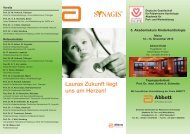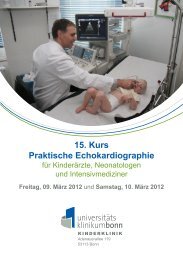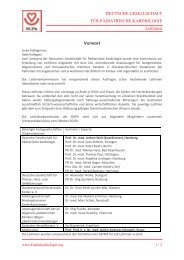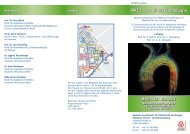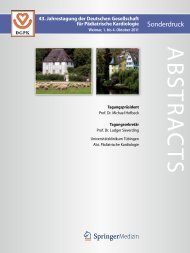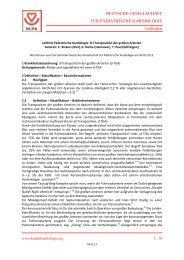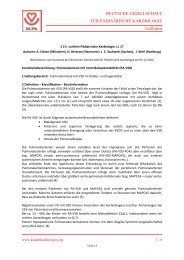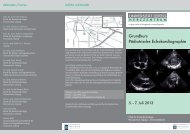Abstraktband als pdf - DGPK-Deutsche Gesellschaft für Pädiatrische ...
Abstraktband als pdf - DGPK-Deutsche Gesellschaft für Pädiatrische ...
Abstraktband als pdf - DGPK-Deutsche Gesellschaft für Pädiatrische ...
Sie wollen auch ein ePaper? Erhöhen Sie die Reichweite Ihrer Titel.
YUMPU macht aus Druck-PDFs automatisch weboptimierte ePaper, die Google liebt.
44. Jahrestagung der <strong>Deutsche</strong>n <strong>Gesellschaft</strong> für Pädiatrische Kardiologie<br />
– Abstracts –<br />
23<br />
Functional Potts-Shunt: an additional therapeutic option<br />
in patients with out of proportion “suprasystemic” CR14<br />
pulmonary arterial hypertension<br />
H. Latus (1), B. Gerstner (1), C. Apitz (1), C. Jux (1), J. Bauer (1),<br />
H. Akintuerk (1), D. Schranz (1); Pediatric Heart Center, JLU-Giessen<br />
Background: Creation of a Potts-Shunt has been propagated in patients<br />
with idiopathic pulmonary arterial hypertension (PAH) with the aim to<br />
decompress the failing right ventricle (RV) and support left ventricular<br />
diastolic function by allowing right-to-left shunting. Three consecutive<br />
patients with different types of PAH are presented, in whom such a functional<br />
right-to-left shunt was created for life saving.<br />
Methods: Hybrid approach by percutaneous PFO creation combined with<br />
surgical graft tube from LPA to DAO was performed in a 20-year-old<br />
man (listed for HLTx) with out of proportion PAH caused by a borderline<br />
left ventricle. Two patients aged 3 weeks (PPHN and small VSD) and 11<br />
months (primary PAH and associated small ASD) were treated by percutaneous<br />
stent-implantation in the still tiny persistent arterial duct.<br />
Results: After uneventful peri-interventional/surgical period, all patients<br />
improved functional class. “Harlequin”-like oxygen saturation pattern<br />
with desaturation of the lower body part was associated with a significant<br />
decrease of the PAP. In the adult patient with post-capillary induced<br />
suprasystemic PAH, Potts-Shunt combined with PFO creation let to a<br />
significant decrease (28 to 15 mmHg) of left ventricular end-diastolic<br />
pressure together with an improvement of RV function (ejection fraction<br />
from 16 to 27%).<br />
Conclusions: Patients with suprasystemic/out of proportion PAH of varying<br />
aetiologies may benefit from pulmonary-to-systemic connection allowing<br />
right-to-left shunt. Creation of a functional Potts-like anastomosis<br />
either by a surgical tube or by stent implantation in the arterial duct<br />
changes cardiac pathophysiology into that of Eisenmenger’s physiology<br />
with the benefit of preserved highly oxygenated coronary and cerebral<br />
blood flow.<br />
Congenital left coronary ostial atresia or stenosis–a series<br />
of four neonatal fatal cases<br />
CR16<br />
D.Laux , F.Bajolle,Y.Boudjemline,D.Bonnet; Centre de Malformations<br />
Cardiaques Congénitales Complexes-M3C-Necker,Hôpital Necker<br />
Enfants Malades,Paris,France<br />
Introduction: Congenital left coronary ostial atresia or severe stenosis<br />
is an extremely rare coronary abnormality. The clinical picture is either<br />
cardiac failure in the small infant or chest pain in the older child or adult<br />
patient. This report describes four neonatal cases of this rare abnormality.<br />
Methods: We retrospectively accessed all cases of left coronary ostial stenosis<br />
or atresia seen in our center during an 11-year-period (2000–2011).<br />
Two older patients with this diagnosis seen at 18 months and 4 years were<br />
excluded from the study.<br />
Results: Four neonates with the diagnosis of left coronary ostial atresia<br />
or stenosis were identified. One newborn died within minutes, the other<br />
within hours after birth because of cardiac failure refractory to all treatment<br />
strategies. In both cases left coronary stenosis was diagnosed at<br />
autopsy. The third neonate was in cardiac failure due to a severe aortic<br />
stenosis. Left coronary ostial atresia was diagnosed during emergency<br />
catheter procedure. The infant subsequently died after the aortic dilatation.<br />
The forth infant had a cardiac arrest at the third day of life and was<br />
diagnosed with left coronary ostium atresia by coronary angiography performed<br />
because of persistent biventricular dysfunction. She died during<br />
the attempt of revascularization surgery at 2 weeks of life.<br />
Conclusion: Congenital left coronary ostium atresia or stenosis is very<br />
rare. Coronary angiography is the diagnostic method of choice especially<br />
in the small child. Revascularization surgery seems indicated in symptomatic<br />
children based on case reports and smalls series. The clinical<br />
picture described here for the first time in the neonate is dramatic and<br />
quickly fatal with scarce surgical options. Systematic examination of the<br />
coronaries should be part of any neonatal autopsy.<br />
Eine neue katheter-interventionelle Strategie zur<br />
intra-kardialen Konnektion einer totalen<br />
Lungenvenenfehlmündung (TAPVR) bei Neugeborenen mit<br />
hypoplastischem Linksherzsyndrom (HLHS) vor<br />
Hybridbehandlung<br />
CR15<br />
C. Jux (1), J. Bauer (1), H. Akintuerk (2), K. Valeske (2), D. Schranz (1)<br />
Abteilung für Kinderkardiologie (1), Abteilung für Kinderherzchirurgie<br />
(2), Kinderherzzentrum der Justus-Liebig Universität, Giessen<br />
Hintergrund: Wir stellen eine neue katheter-interventionelle<br />
Strategie zur intrakardialen Konnektion sowohl einer klassischen totalen<br />
Lungenvenenfehlmündung vom suprakardialen Typ <strong>als</strong> auch in<br />
Assoziation mit einem cor triatriatum sinistrum bei Neugeborenen<br />
mit hypoplatischem Linksherzsyndrom vor. Methode: Bei drei<br />
Neugeborenen wird mittels perkutaner Hf Radiofrequenz-Technik, gradueller<br />
Ballondilatation und Rashkind (n=2) oder Stentimplantation<br />
(n=1) in das Diaphragma bei cor triatiatum (n=2) oder die Wand zwischen<br />
Vorhof und Lungenvenenkonfluenz (n=1) eine Kommunikation<br />
zwischen Lungenvenenkonfluenz und Vorhof geschaffen.<br />
Ergebnisse: Die Dekompression des Lungenvenenkonfluenz wurde bei<br />
allen drei Kindern mittels des katheter-interventionellen Verfahrens erzielt.<br />
Klinisch fassbare Komplikationen traten dabei nicht auf. Alle Patienten<br />
erhielten nachfolgend ein bilaterales Pulmonalarterien-Bändchen sowie<br />
eine Duktusstentimplantation. Zwei Patient erhielt bereits den comprehensive<br />
stage II mit Aortenbogenrekonstruktion und bidirektionaler<br />
Glenn-Anastomose, der dritte Patient erwartet diese Operation. Bei ihm<br />
zeigte die invasive prä-operative Diagnostik im Alter von 4 Monaten eine<br />
frei Kommunikation zwischen Lungenvenenkonfluenz und Vorhof ohne<br />
Druckgradienten.<br />
Schlußfolgerung: TAPVR bei HLHS ist eine seltene Assoziation, die in<br />
therapeutischer Hinsicht mit einem hohen Aristotle score und somit hoher<br />
Mortalität einher geht. Unsere neuartige perkutane Technik zur intrakardialen<br />
Konnektion einer suprakardialen TAPVR bei insg. 3 Neugeborenen<br />
demonstriert die Effektivität dieser innovativen Behandlungsalternative<br />
bei TAPVR und HLHS mittels Hybridtherapie.





